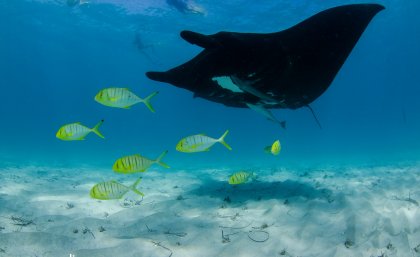
‘Whoopi’ the manta ray – a regular visitor to Western Australia’s Ningaloo Reef – has helped University of Queensland and Murdoch University scientists study rays’ impressive ability to heal.
Whoopi, who has swum with thousands of tourists WA’s over the years, was hit by a boat in 2015, suffering propeller cuts measuring up to 20 centimetres to the edge of her wing.
Dr Christine Dudgeon from UQ’s School of Biomedical Sciences said such a strike was relatively rare, but could cause significant injuries to the animal.
“Manta rays don’t surface to breathe, which you think would reduce their susceptibility to boat strike,” Dr Dudgeon said.
“But these rays, like whale sharks, tiger sharks and other sharks and rays, spend considerable time in surface waters for activities like basking and feeding.
“Most wounds in these species have been attributed to predation, mating attempts and fishing-related injuries or entanglement, but boats do end up hitting some rays – and Whoopi had the cuts to prove it.”
Manta rays and other sharks and rays are considered to have high healing capacity.
“This is likely due, in part at least, to a unique adaptive immune system,” Dr Dudgeon said.
“However, few studies have investigated the rate of wound healing in sharks and rays, and these have mostly focused on the impacts of external and internal tagging procedures, not boat strikes.”
 To investigate this phenomenon further, the team compared underwater photographs taken in the Ningaloo Coast World Heritage Area of WA over the past 15 years, and found evidence of greater incidence of boat strike on manta rays than previously thought.
To investigate this phenomenon further, the team compared underwater photographs taken in the Ningaloo Coast World Heritage Area of WA over the past 15 years, and found evidence of greater incidence of boat strike on manta rays than previously thought.
Professor Anthony Richardson from UQ’s Centre for Applications in Natural Resource Mathematics said the results were impressive.
“Whoopi showed us just how fast these beautiful creatures can heal,” he said.
“Her significant wounds had healed by 50 per cent only 46 days after the boat strike, and by day 295 had healed by 95 per cent.”
Dr Dudgeon said the research could be used to inform policy for designing adequate spatial management for the region.
“It’s imperative we reduce the impact of vessels on manta rays and protect their critical habitat,” she said.
“Such management may include speed restrictions during high usage periods, vessel free zones, the use of propeller guards or alternative motors – like jet motors – and public education on vessel-wildlife conflict.”
“Manta rays are incredible healers, but it’s important we keep them safe in the first place.”
The research has been published in PLOS One (DOI: 10.1371/journal.pone.0225681).
Funding for the project was provided by Austral Fisheries, TG Kailis Marine Conservation Fund, Earthwatch, Australian Research Council and UQ.
Image above left: Images of the wounds from Days 0, 17, 33, 42 and 295 (A-E respectively) showing the fresh wound, incremental healing and near stable wounds on reef manta ray. On the right are close up images of Day 0 (i) showing severed cartilage, Day 7 (ii) (time not used in calculations) showing the start of healing, and Day 295 (iii) showing near complete healing with concave scars. The red arrows in (i) indicate the protocol for measuring each wound where the distance from the top of the wound to the mid-point between the adjacent sides at the extremity was used to indicate wound length.
Media: Dr Christine Dudgeon, c.dudgeon@uq.edu.au, +61 423 366 398; Professor Anthony Richardson, ajr@maths.uq.edu.au, +61 467 771 869; Dominic Jarvis, dominic.jarvis@uq.edu.au, +61 413 334 924.



